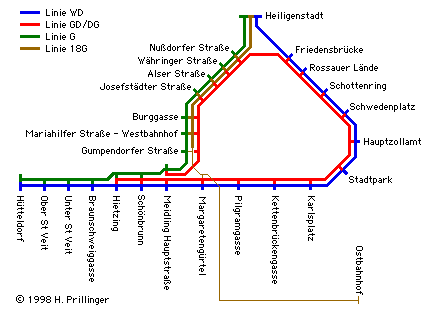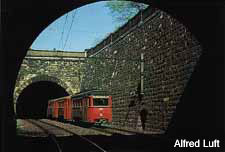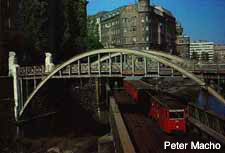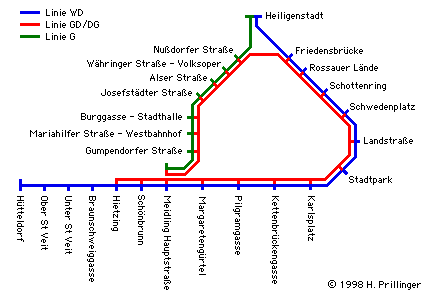The Electric Metro (1925-1989)
The steam Stadtbahn had to close in 1918 due to the coal shortage after World War I. The city of Vienna was granted a 30-year lease on the track and stations of the Wiental, Donaukanal and Gürtel Lines, provided they would electrify them; the other lines remained with the federal railways.
This meant the end of the Metropolitan Railway as a full-scale regional railway. The connecting rails to the national rail lines at Heiligenstadt, Hauptzollamt and Hütteldorf were removed and reversing loops built in their place. When the metro re-opened in 1925 as "Wiener Elektrische Stadtbahn" (Vienna Electric Metro), the Stadtbahn had become an urban "metro" in the literal sense of the term: a high-capacity urban railway system running on its own track, with the following lines:
- WD: Hütteldorf - Wien valley - Danube Canal - Heiligenstadt
- GD: Meidling Hauptstrasse - Outer Ring - Danube Canal - Wien valley - Hietzing
- DG: Hietzing - Wien valley - Danube Canal - Outer Ring - Meidling Hauptstrasse
- G: Hütteldorf - Wien valley - Outer Ring - Heiligenstadt (peak hours and Sundays only)
- 18G: Ostbahnhof - tram route 118 - Westbahnhof - metro route G - Heiligenstadt

For a variety of reasons (the limited lease being one of them) the city chose to use rolling stock that could also be used on the tram system. So yet again, the metro became victim to a compromise.

N1/n2 stock near Westbahnhof

N1/n2 crossing the river Wien
Most of the metro was destroyed by bomb attacks during World War II, and it was only in 1954 that the entire network was again fully operational. However, line 18G remained closed and line G terminated at Meidling Hauptstrasse, but was now operated daily.

In the 1960s, when the metro was already owned by the city, the federal railways showed interest in buying it back and to use it as part of the rapid transit (S-Bahn) project and for goods trains, but no agreement was reached.
The decision to build a full-scale modern metro meant the end of the term "Stadtbahn", as line WD was to be converted to line U4, and line G was to be removed completely and replaced by an urban motorway — there were plans to build line U6 completely new in a tunnel below a parallel street.
Line WD was converted between 1976 and 1981, and fortunately, the urban motorway plans were shelved again, so the railway viaducts remained in place. The line was only modernised, but not converted, renamed to U6 and extended to the north and south between 1989 and 1996.